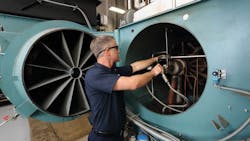Leveraging Annual Boiler Shutdowns for Safety and Efficiency
With the average boiler consuming more than four times its initial cost in energy every year, there is no bad time to look for ways to increase efficiency and perhaps no better time than during the annual shutdown. If shutdown is performed properly and appropriate action is taken, a boiler not only will operate more efficiently and reliably, it will continue to run safely.
During an annual boiler shutdown, inspect all of the equipment in the boiler room. Walk around the boiler before looking inside. Check for “hot spots,” which may indicate compromised insulation or gasketing. Look at the external piping, valving, feed system, pumps, and pump seals, and note any leaks. Listen for bearing or cavitation noise. Check the alignment of the pumps, motor assemblies, and water softener. Check the brine tank for salt, and measure brine-water levels.
Next, shut down and secure the boiler. Use the dry method of layup to prevent corrosion while the boiler is open for maintenance. Once the boiler is open and the manway and handhole plates are removed, look for evidence of scaling or corrosion on the waterside, and clean or replace tubes as necessary. On the fireside, evaluate the condition of the gaskets, and replace any that are dried out, brittle, or cracked. Check the door refractory for cracks. Cracks less than an eighth of an inch will seal themselves when the boiler is under fire. Cracks greater than an eighth of an inch must be patched with an approved material; otherwise, further deterioration will occur, and the entire door may have to be replaced.
Check the throat tile and furnace liner. Throat tile insulates and shapes, aiding combustion, while furnace liner protects against extreme temperatures in front of a burner. It is very important they not be compromised. If there are cracks or large chunks missing, repair them. Otherwise, you will have to replace the throat tile or liner in the future. While completing these actions, thoroughly clean the fireside surfaces, knowing that a high degree of soot could mean the burner needs to be tuned and/or the supply of combustion air is inadequate.
Check the burner-drawer assembly and burner housing. In the case of the burner housing, you are looking for evidence of cracking or warping from excessive heat. If you see cracking, bending, or deformation of the burner baffle or diffuser, replace it, for it must be intact for proper mixing of fuel and air. Sometimes, air-damper blades get distorted or bearings wear; ensure they move freely with no binding. If a problem is suspected, address it immediately.
The next thing to consider, as far as the burner is concerned, is the scanner. Make sure there is no cracking or clouding. The scanner tube and eye must be in excellent condition to pick up the flame signal. Look closely at the pilot tube. It contains the pilot spark electrode. If it is corroded or burned or space between the tip of the electrode rod and inner pilot tube is lacking, the electrode will not have sufficient intensity to ignite.
Follow the manufacturer’s instructions when closing the boiler. Remove the boiler from layup state using recommended procedures. Bolt, seal, and torque accordingly.
Next, take a close look at the controls. Is the wiring of the pressure controls brittle, or is there evidence of overheating? What is the color of the mercury in the switches? If it is caramelized or brown, replace the control. Today, there are combination controls that do not contain mercury.
In a single-point positioning system, check linkages for wear and slippage, which can cause unreliable air/fuel-ratio control throughout the modulating range. This is extremely wasteful of fuel and can increase sooting. Consider replacing a single-point positioning system with parallel positioning, which takes stretch, hysteresis, and wear out of the equation. Depending on the amount of modulation, you will lower fuel costs by 0.5 to 2 percent.
Next, closely examine the low-water cutoff. Clean and inspect the probes; if a probe is deteriorated, replace it. Verify wiring is not cracked or broken and terminal connections are clean and tight. Recognizing that many boiler occurrences result from a failure in low-water-cutoff control, today’s design engineers are creating controls that detect potential low-water problems early.
Lastly, direct your attention to the burner-management and combustion controls. If they are old and outdated, consider a progammable-logic-controller- (PLC-) based platform. PLC-based platforms are expandable to include parallel positioning, oxygen trim, draft control, etc. They include powerful communications for operating-parameter indication, historic-data gathering, trending, and alarms.
A boiler that is clean and operates properly is essential, but do not overlook support systems, including:
• Makeup-air louvers. Ensure they are clean. Dirty louvers inhibit the free flow of combustion air.
• Valves and fittings. Repair leaks. Leaks require the introduction of cold makeup water into a system, with additional heat input and chemicals.
• Chimneys and flues. Ensure chimney and flue terminations are clean and clear. Test mechanical vent systems for proper operation. An improperly operating vent system affects combustion efficiency.
• Water chemistry. Verify water-testing equipment is calibrated properly and not beyond its expiration date. Improper water chemistry leads to scaling and corrosion. If a boiler has a hot-water heating system, verify glycol levels are correct.
In the final analysis, it is critical that an annual boiler shutdown be part of your standard operating procedures and that your technicians be trained to perform a thorough inspection and combustion tune-up.
John Pemerton joined Cleaver-Brooks as warranty and service manager for packaged boiler systems in August 2013. Prior to that, he worked for Lochinvar as risk/product liability manager. He began his career with the U.S. Navy as a boiler technician and also has worked as a manufacturer’s representative for a boiler company. He can be reached at [email protected].
Did you find this article useful? Send comments and suggestions to Executive Editor Scott Arnold at [email protected].
